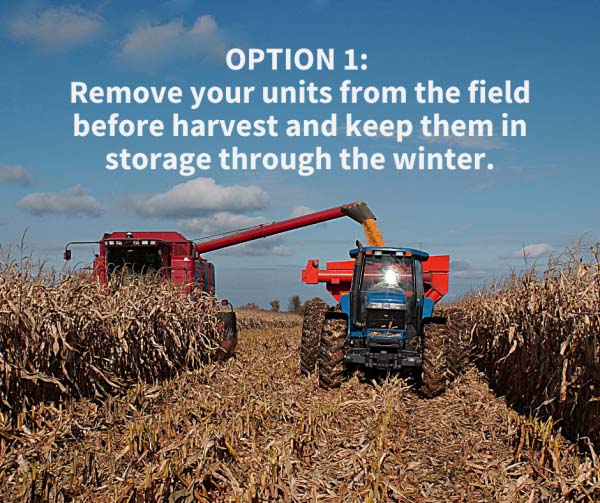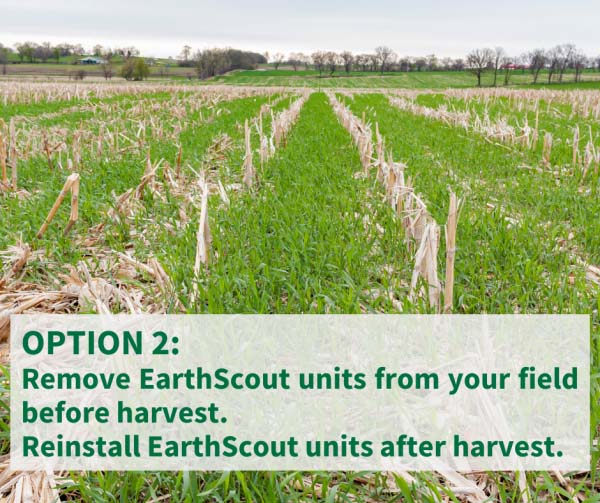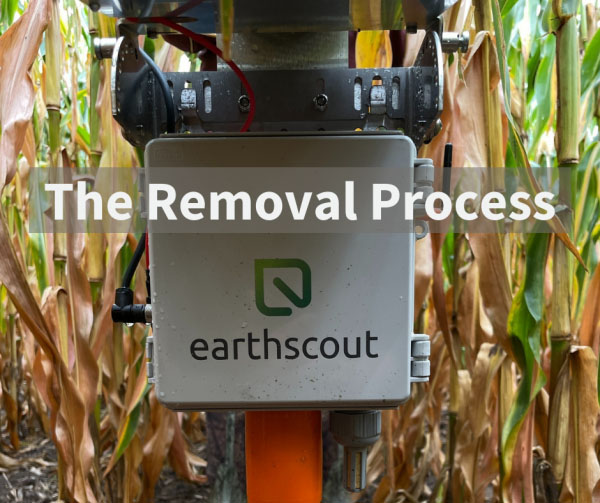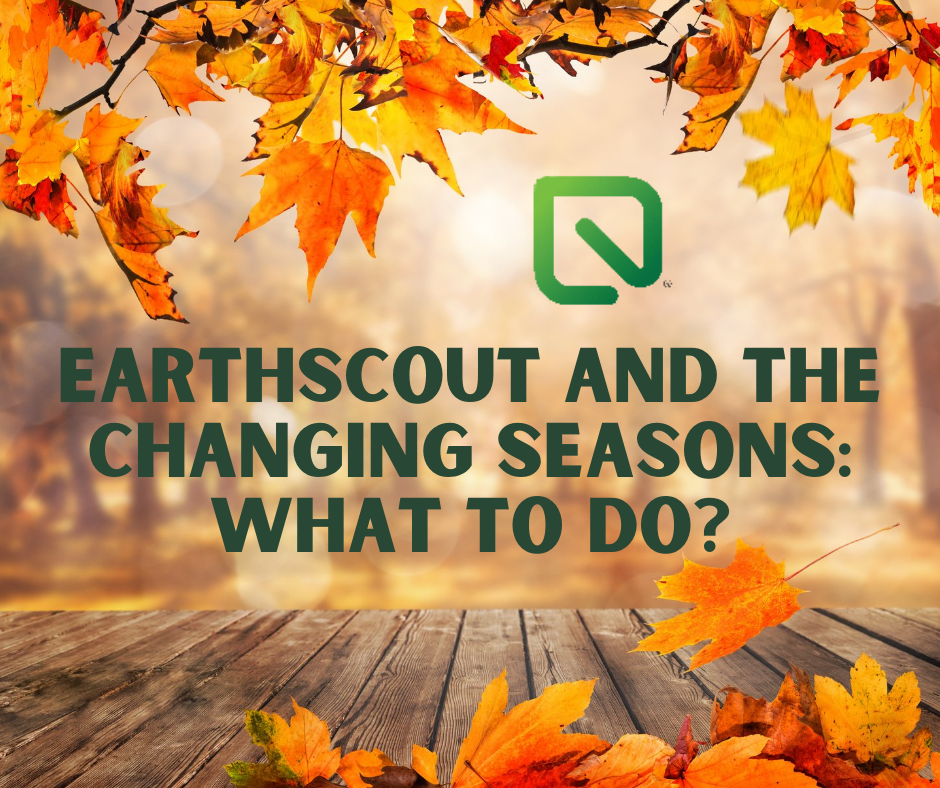EarthScout is an IoT, smart farming device that monitors your fields above and below ground, and in real-time. As long as your unit(s) are installed in your field(s), you are gathering valuable data that can be used in season to make important decisions and more efficiently manage your inputs/resources. When you leave your EarthScout in your field year-round, you gain long-term insights as to how your fields retain moisture, as well as soil temperature trends leading up to the Spring planting season.
Don’t know or can’t decide what to do with your equipment this Winter? No problem! We are here to offer you advice and we understand that every operation and circumstance is different.
Let’s focus on harvest, first off…
Harvest is a busy time, and it is important to remember where your EarthScout units are out in your field, so you don’t damage them with your harvesting equipment (or vice versa)! Our products are tough and built to withstand harsh elements, but scientific equipment will not win in a battle with a combine.
In some cases, your EarthScout may not be in jeopardy of your equipment during harvest. In this case, feel free to leave your unit in place if you’d like.
Below you will find a few options to get you through harvest with your EarthScout and what we believe the pros and cons are of each.
We have also included a step-by-step removal process to assist you in your field when it comes time to remove your unit. We even sprinkled in some tips and tricks to help!

Pros:
- Your units are stored in a safe place over winter, ready for action come Spring!
Cons:
- You may miss out on collecting valuable late season data and early season data.
We will offer tips on storage later…

This option is best for a grower who wants to collect data year-round or a grower with a double crop or cover crop scenario.
Pros:
- Track how moisture events move through your soil profile after your crops have been harvested.
- Measure rate of soil temperatures cooling down in the fall and warming up in the spring.
- Access field specific soil temperatures and soil moisture which allows you to safely make planting decisions
- Prevent planting into soils that are too cold or too wet for seed germination
- Effectively apply fertilizers in ideal field conditions
- Know precisely what your soil moisture is to avoid running machinery over fields that are too wet, which can lead to compacted soils over time.
- Compacted soils have negative effects on germination rates in the spring and water infiltration throughout the growing season.
- Compare how different crop types or amounts of plant residue (soil organic matter) in your fields affect soil moisture and soil temperature to help make important decisions
- This can help you choose the right cover crop mix or perhaps try planting something new
- Having a large soil temperature and moisture data set over time can help you decide which crops are creating more ideal soil conditions and what fields may need help
Cons:
- You will have to remove the unit before harvest and then go back and install the unit after harvest to keep collecting data.

We highly recommend that you keep the black suitcase box with customized padding for your unit. The safest way to uninstall your unit would be to bring this box to the field with you for removal.
- Pull on the pins that hold up the solar panel and raise the panel into a horizontal position, exposing the control box.
- Open the control box to remove the battery.
a. Removing the battery ensures that the unit stops sending useless data packets
b. When storing your unit, you want to keep the battery removed and stored in a cool, dry place to ensure longevity - Close the control box after battery is removed
- Pull on the solar panel pins and lower the solar panel to a vertical position, flush with the control box
- Carefully disconnect the sensor cords that are connected to the EarthScout unit.
- Use the Velcro strap attached to the cords to wrap them neatly for storage.
- Remove the soil sensors from the ground
a. When it comes to removing the soil sensors, dig carefully around the area taking care not to cut the cords attached to the soil sensors.
***Hot tip: try using a hand trowel to dig up soil sensors instead of a shovel - After the probes are removed, wipe them off with a damp cloth either place them in appropriate place in box or holster them to the side of the EarthScout unit.
- If you have additional sensors (ie: Oxygen, Frost, Leaf Wetness, Solar Radiation, etc…) use caution when removing, as to not break or damage.
a. There should be space in your box to store these additional sensors
b. If you lost your box, be sure to wrap sensors in something soft for storage (especially in the case of the solar radiation sensor.) - Pull the EarthScout unit with feet out of the ground
a. The claw feet of the unit are designed to be loosened, which allows you to align the claws together for easier storage.
General Removal Tips for Your Consideration:
- The Health sensor (Air Temp/Humidity) should NOT be removed for any reason, including storage.
- We highly recommend keeping the box your EarthScout came in for storage purposes. If you do not have the box, find some place safe to store all your materials and extra batteries/charger so they do not get damaged or lost.
- Remove the battery from the EarthScout unit when not in use. This ensures that the unit will not send data while in storage and saves the battery for the next installation.
- You can remove the above ground portion of your unit and leave the sensors buried in the field if you would like.
- If leaving the soil probes in the ground over winter and taking the unit out of the field, make sure to clearly mark or flag where the soil sensors are in the field.
- Using a small hand trowels to dig up soil probes will lessen the chance of the soil probes cords being cut during removal.
- The unit will not be stable if it is not anchored in soil so try to store the unit horizontally or in a stable upright position.
- If your unit has a solar sensor keep in mind that it is one of our most fragile sensors, you can protect it by wrapping it in bubble wrap or other packing material.
We highly recommend growers utilize sustainable practices such as cover crops to build organic matter of the soil, which in turn increases the stability of your soil, as well as the water and nutrient holding capacity of your fields. You can directly measure the effects of whichever practices you choose by gathering year-round data from your fields.
Monitoring your field trends year round, on an annual basis gives you insights into: The rate at which the soil warms up in the spring for planting, how water moves through the soil profile after moisture events, how much water your soil can hold, and how different cultural practices affect your crop this year and for years to come.
If storing your EarthScout field sensor indoors over winter, don’t forget to install your units as close to Spring planting as possible. This data is critical for calculating hyper-local Growing Degree Units (GDU), which will help predict pest and plant disease emergence and plant maturity for making important decisions in season. We will take a deep dive into calculating in field GDUs in our blog leading up to Spring planting in 2022!
To learn more about how you can take advantage of new IoT farm technologies, please contact us on our website or at (877) 443-7632.
